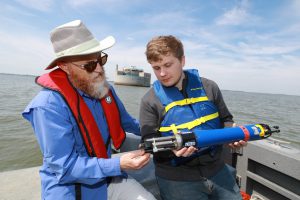Algae researchers to fan out across Lake Erie to collect water samples Aug. 7
August 2nd, 2019 by Christine BillauFive years after a water crisis in Toledo left half a million residents without safe tap water for three days, environmental scientists from the U.S. and Canada will board research vessels and fan out across western Lake Erie to collect water samples at nearly 200 locations in four hours in a united effort to create a high-resolution picture of this summer’s harmful algal bloom (HAB) and ultimately protect the public drinking water supply.
The second annual HABs Grab on Wednesday, Aug. 7 brings together researchers from The University of Toledo, National Oceanic and Atmospheric Association (NOAA) Great Lakes Environmental Research Laboratory, Ohio State University, University of Michigan, Bowling Green State University, Wayne State University, Michigan Technological University, Cooperative Institute for Great Lakes Research (CIGLR) and LimnoTech. The HABs Grab has nearly doubled in size this year with the addition of Canadian partners, including the University of Windsor, Environment and Climate Change Canada, and the Department of Fisheries and Oceans.
Members of the media are invited at 12:30 p.m. to the UToledo Lake Erie Center, 6200 Bay Shore Road in Oregon, as researchers reunite to process water samples in the laboratory.
 A major goal is to estimate the mass of total microcystin toxin for one day during the peak of algal bloom season as well as to characterize the different forms of microcystin and the genes that produce them.
A major goal is to estimate the mass of total microcystin toxin for one day during the peak of algal bloom season as well as to characterize the different forms of microcystin and the genes that produce them.
“Collaboration is critical in our efforts to understand a harmful algal bloom as large as Lake Erie’s – the lake is simply too large for one organization to handle,” Dr. Thomas Bridgeman, director of the UToledo Lake Erie Center and professor of ecology, said. “This massive one-day sampling event allows us to not only analyze the current bloom, but focus on unraveling the mystery of why some algal blooms are highly toxic, while others are less so.”
Bridgeman, who has studied algae in the Great Lakes for nearly two decades, and his research team at UToledo collect samples and track cyanobacteria throughout Lake Erie’s western basin once a week every summer during algal bloom season.
“Harmful algal blooms are an international issue,” Bridgeman said. “The ultimate solution is to prevent blooms from growing in the first place by preventing water pollution. In the meantime, discovering what triggers a bloom to start producing toxins would be a large step toward protecting people, pets and wildlife.”
HABs Grab is funded by NOAA’s ECOHAB research program.
“The main goal of the project is to develop a bloom toxicity forecast, and the HABs Grab provides data to estimate toxin mass in the lake,” said Dr. Justin Chaffin, leader of the HABs Grab project who is based at Ohio State University’s Stone Laboratory. Chaffin earned his Ph.D. in biology from UToledo in 2013 while studying in Bridgeman’s lab. He also earned his master’s degree in biology from UToledo in 2009.
“This coordinated effort will assist in improving the accuracy of microcystin toxin concentrations in HAB forecast products,” Deborah Lee, director of the NOAA Great Lakes Environmental Research Laboratory, said. “It is a true testament to collaboration and coordination across institutional and international boundaries.”
The Lake Erie Center is UToledo’s freshwater research and science education campus focused on finding solutions to water quality issues that face the Great Lakes, including harmful algal blooms, invasive species and pollutants.
Christine Billau is
UT's Media Relations Specialist. Contact her at 419.530.2077 or christine.billau@utoledo.edu.
Email this author | All posts by
Christine Billau

